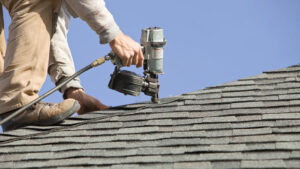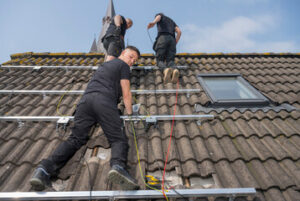A new roof improves your home’s curb appeal and protects you from elements that damage the interior of your home. It can also help reduce your energy costs.

Roof Replacement NJ also offers a strong return on investment when it comes to resale value. Homebuyers are often willing to pay more for a house that has been recently upgraded with a modern, efficient roof.
The cost of a new roof is one of the most significant investment homeowners can make in their home. A sturdy, well-constructed roof protects the occupants and contents of the house and can add considerable value to the property in case the homeowner decides to sell it. It is therefore important to plan ahead and carefully consider all the elements that impact the costs of a new roof.
The majority of the costs associated with a roof replacement are related to labor and materials. The actual roofing material itself varies in price considerably from product to product, so it is essential that the homeowner understands what each option entails and selects an affordable yet high-quality roofing solution. The home size, location and unique features also influence the total costs, as some roof types are better suited to certain materials than others.
Other factors that affect the cost of a roof include the pitch (angle) of the roof and any features like chimneys or skylights that may need to be replaced. A steeper roof requires more materials, painstaking labor and often special equipment to install, which will drive up the overall cost of the project.
In some cases, a homeowner may be able to file an insurance claim for part or all of the cost of a new roof if it is necessary due to storm damage. It is a good idea to contact a local insurance agency to see what coverage options are available.
Homeowners should also budget for removal and disposal fees for the old roofing materials. Many states and cities have regulations on how and where this waste can be disposed of, which can drive up the overall cost of the project.
It is a good idea for homeowners to have a clear understanding of the full costs involved in a roof replacement before starting the project. The best way to do this is to consult with several contractors to receive estimates for the job. Then, the homeowner can choose a contractor that is willing to work within their budget and meets their quality requirements.
Materials
A roof replacement involves a substantial investment, and you want to choose the best material to protect your home. You want a durable material that is affordable and easy to maintain. You also need a roof that will add value to your home if you decide to sell it in the future.
Many homeowners choose asphalt shingles, which offer a good balance of price and longevity. They are durable and can last up to 20 years. They are also inexpensive and easy to repair. If you’re looking for a more luxurious roofing option, you may want to consider wood shingles or shakes. These look more attractive and can raise your home’s value. However, they can be prone to plant and moss growth.
Tile and slate are mid-range materials. They’re heavier than shingle roofs, and you may need extra support to handle the weight. However, they can last up to 100 years or more. They’re also a great choice for hot climates, as they help your home retain cool air.
You can also choose metal roofs, which are relatively inexpensive and can last 30 to 50 years. They’re suitable for many climates, and they can even mimic the appearance of traditional asphalt shingles or cedar shakes.
If you’re not sure which material to choose, talk to a roofer. They can advise you on what works well for your area, and you can compare costs. They’ll also provide you with a manufacturer warranty that will protect you from problems like leaks for years to come.
A new roof can take a lot of time to install, so you’ll need to be patient during the process. You’ll have to deal with hammering, drilling, and other noises for several days or weeks while your roof is being replaced. You can prepare for this by moving your valuables to a safe location or by staying away from the house during the work period.
Installation
If your roof has been damaged to the point that a full replacement is needed, it will typically take one or two days to complete. After the new roof is installed, the contractor will clean up your property and inspect the work to ensure it meets quality standards. They will then clean up all of the old roofing materials and dispose of them appropriately.
To prepare for a new roof, the crew will set up protection on your property to keep debris and other items out of the way while they are working. This includes tarps that cover cars and other items, as well as heavy duty plastic sheets that cover the decking of your home. Once everything is ready, they will begin to tear off your old roof and expose the underlying sheathing and rafters. If necessary, they will make repairs to these structural components.
Once the existing shingles are removed, they will install a water-repelling underlayment to protect the wooden structure of your roof. This material will stop moisture from getting between shingles and can prevent the wood from rotting and becoming weak over time. The crew will then lay down rows of asphalt roofing paper to form an inner barrier against rainwater. The roofer will also put down a metal drip edge to prevent moisture from pooling at the base of the shingles.
Depending on your geographic location, the roofer may also install ice dam protection to prevent melting snow from backing up under the shingles and penetrating through the sheathing. Finally, the installer will add or replace any flashing at areas of the roof that are prone to leaks, such as around chimneys, skylights, pipes, vents, and roof valleys.
Once the installation is complete, the contractor will remove all of the tarps and debris from your property and go over your lawn to pick up nails and other debris that fell during the project. If you are interested in having a roof installed, it is important to choose a qualified contractor that has the proper insurance coverage and workers’ compensation for the safety of their employees. You should also request a copy of the contract before making any payments and ask about their quality control process.
Warranty
When getting a roof replacement, it’s important to understand the different types of warranties that are available. There are different manufacturers’ warranties and contractor workmanship warranties, as well as extended and upgrade warranties that can be purchased.
Manufacturer warranties typically guarantee the materials that were used in your roof replacement, and they will usually cover any issues related to those materials for a set amount of time after the roofing project is complete. Contractor workmanship warranties, on the other hand, cover the labor that was performed by the contractor during the installation process. These warranties also typically have specific stipulations and conditions that may cause them to be voided if not followed correctly.
Some of the most common issues with roof repairs and replacements are due to faulty or improper installation. That’s why it’s so important to choose a professional roofing contractor for your roof replacement. They should have a good track record and a solid reputation in the industry. They should also be licensed and insured to work in your community.
You should also ask your prospective roofing contractor about the type of warranty they offer and what it covers. They should be able to provide you with all of the information you need to make an informed decision about which warranty is right for you.
It’s also important to note that most of these warranties are only valid if you register them with the manufacturer. It’s a good idea to do this as soon as possible, as it will ensure that you get the coverage you deserve if something goes wrong with your roof.
In addition, you should try to keep the same contractor throughout the duration of your warranty in order to protect it. Many manufacturers have strict policies that will void the warranty if another contractor is hired for repairs or maintenance, so it’s best to stick with your original roofing contractor. This way, they will be familiar with your roof and its needs and will be able to address any concerns faster. It will also help you to avoid any unnecessary or unneeded expenses in the future.
